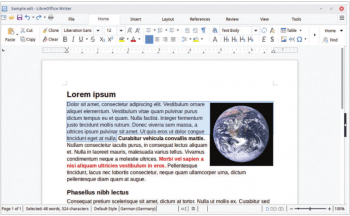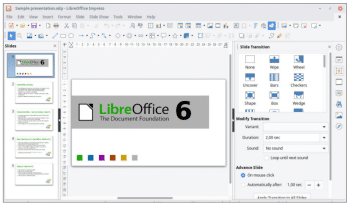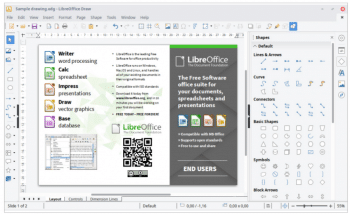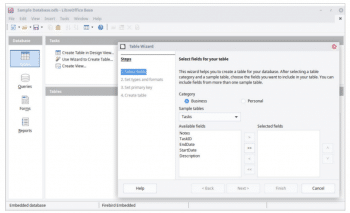Business and productivity are two sides of the same coin. The use of open source software promotes productivity by removing several bottlenecks like vendor lock-in, the unnecessary expense when using proprietary software, issues involved in the maintenance of the software, etc. This article highlights the LibreOffice suite.
Businesses that restrict themselves to proprietary software like Microsoft Office get a raw deal. Not only do they have to pay for the software but they have to factor in the cost incurred every time the software becomes corrupt. This includes the fee to be paid to the computer technician to re-install the software. All this creates a vicious cycle, where costs and delays keep mounting. Ideally, every business should aim to develop a system that automates maintenance to the maximum possible extent.
This is where open source software like LibreOffice, Apache OpenOffice, Scribus, GIMP, Inkscape, Firefox, Thunderbird, WordPress, VLC media player, etc, come in. Open source software is used in my company to the maximum extent possible, helping to streamline business processes. This practice makes updating the software and maintaining it very easy. The required software can be freely downloaded from the Internet, and periodic updates can be easily applied by simply downloading the latest version of the software. With free and open source software (FOSS) anyone is licensed to use, copy, study and change the software in any way and the source code is openly shared; so people are encouraged to voluntarily improve the design of the software. This is in contrast to proprietary software, for which the software is under restrictive copyright and the source code is usually hidden from users. The benefits of using FOSS include lower software costs, higher security and stability (especially with regard to malware), better privacy protection and more control over the hardware.


So, let us take a brief look at one of the key open source software, LibreOffice.
LibreOffice and Apache OpenOffice are two actively developed forks of OpenOffce.org, which is no longer being developed. LibreOffice is being developed by The Document Foundation, and is a powerful and free office suite, used by millions of people around the world. Its clean interface and feature-rich tools help people unleash their creativity and enhance their productivity.
LibreOffice includes several applications that make it the most versatile free and open source office suite in the market. It comes with Writer (word processing), Calc (spreadsheets), Impress (presentations), Draw (vector graphics and flowcharts), Base (databases) and Math (formula editing). Documents look professional and clean, whatever their purpose may be – a letter, a thesis, a brochure, financial reports, marketing presentations, technical drawings and diagrams.
LibreOffice makes the work look great while people focus on the actual content. It is compatible with a wide range of document formats such as Microsoft Word (.doc, .docx), Excel (.xls, .xlsx), PowerPoint (.ppt, .pptx) and Publisher. But LibreOffice goes much further with its native support for a modern and open standard, the Open Document Format (ODF). With LibreOffice, people have maximum control over their data and content and can export their work in many different formats, including PDF.
LibreOffice has a centralised launch centre for all its modules. It was forked from OpenOffice in 2010. Its suite comprises programs for word processing, the creation and editing of spreadsheets, slideshows, diagrams and drawings, working with databases and composing mathematical formulae. It is available in 110 languages. LibreOffice uses the Open Document Format (ODF) natively to save documents for all of its applications. The ODF is a fully open, ISO standardised file format that guarantees access to data forever. Of course, people can encrypt their documents with a password. Because ODF is standardised, other office software can implement support for it as well, and many programs have done so. By using ODF, people ensure that data can be transferred between different computers and operating systems, without having to worry about vendor lock-in or licence fees. ODF also supports the file formats of most other major office suites, including Microsoft Office, through a variety of import/export filters.
Typical extensions for ODF files include the following:
.odt – a text document
.ods – a spreadsheet file
.odp – a presentation file
.odg – an illustration or graphic
If a file with one of the above extensions is received but the software or operating system cannot identify it, then LibreOffice can be easily downloaded to handle all of the above extensions. LibreOffice is available for Microsoft Windows, Linux and MacOS. A LibreOffice Viewer for Android devices is also available. LibreOffice and Apache OpenOffice have similar modules called by the same names —Writer, Calc, Impress, Draw, Math and Base. A key advantage that LibreOffice has over Apache OpenOffice is the ability to save documents in the docx format. Although Apache OpenOffice can read docx documents, it cannot save documents in this format. A brief overview of the modules of LibreOffice follows.
LibreOffice Writer: This is a word processor with similar functionality as, and file support for, Microsoft Word or WordPerfect. It has extensive WYSIWYG word processing capabilities but can also be used as a basic text editor. LibreOffice Writer has all the features people need from a modern, full-featured word processing and desktop publishing tool. It is simple enough for a quick memo but powerful enough to create complete books with content pages, diagrams, indexes and more. People are free to concentrate on the content while LibreOffice Writer makes it look great.
LibreOffice Calc: This is a spreadsheet program, similar to Microsoft Excel or Lotus 1-2-3. It has a number of unique features including a system that automatically defines a series of graphs based on the information available to the user.

LibreOffice Impress: This is a presentation program resembling Microsoft PowerPoint. Presentations can be exported as swf files allowing them to be viewed on any computer with Adobe Flash Player installed. In LibreOffice Impress, creating and editing slides is very versatile thanks to different editing and view modes: Normal (for general editing), Outline (for organising and outlining text content), Notes (for viewing and editing the notes attached to a slide), Handout (for producing paper-based material) and Slide Sorter (for a thumbnail sheet view that lets people quickly locate and order slides).
LibreOffice Draw: This is a vector graphics editor and diagramming tool similar to Microsoft Visio and with features comparable to early versions of CorelDraw. It provides connectors between shapes which are available in a range of line styles, and facilitates drawings such as flowcharts. It includes features similar to desktop publishing software such as Scribus and Microsoft Publisher. It can also act as a PDF file editor.
LibreOffice Math: This is an application designed for creating and editing mathematical formulae. It uses a variant of XML to create formulae, as defined in the OpenDocument specification. These formulae can be incorporated into other documents in the LibreOffice suite, such as those created by LibreOffice Writer or LibreOffice Calc, by embedding them into the document.
LibreOffice Base: This is a database management program similar to Microsoft Access. LibreOffice Base allows the creation and management of databases, and helps users prepare forms and reports that provide end users easy access to data.
Beyond the many features shipped by default, LibreOffice is easily extensible through its powerful extensions mechanisms. People can get even more features and document templates on LibreOffice’s dedicated websites.
In June 2015, Wikipedia revealed that a detailed 60-page report compared the progress of the LibreOffice project with its cousin Apache OpenOffice. It reported that, “Apache OpenOffice received about 10 per cent of the improvements LibreOffice did in the period of time studied.”

LibreOffice Viewer for Android
The Document Foundation provides a LibreOffice Viewer for Android. It is available for download on Google Play. Editing is still an experimental feature, which has to be enabled separately in the settings and is not stable enough for mission-critical tasks. Most editing features have been developed thanks to donations to The Document Foundation. The application is being enhanced to become a full-fledged editing solution with the help of developers.
LibreOffice Viewer uses the same engine as LibreOffice for Windows, MacOS and Linux. This, combined with a new front-end based on Firefox for Android, reads documents similarly to LibreOffice on the desktop. LibreOffice Viewer has been developed by Collabora and Igalia, backed by Smoose, with contributions from Google Summer of Code students, together with The Document Foundation and the LibreOffice community. SUSE has provided the cross-platform support and the Mozilla Corporation has provided several other core components. LibreOffice Viewer can also be installed via F-Droid, or the plain APK can be downloaded and side loaded on a device.
LibreOffice Impress Remote for Android and iOS
The LibreOffice Impress Remote is a handy tool for controlling LibreOffice Impress slideshow presentations from a mobile device.
LibreOffice Online
LibreOffice Online is a server service built from the main LibreOffice project code which provides display and collaborative visual editing of a range of document types. It does not include any form of file system. To be fully functional, it has to be integrated with file access and authentication provision from an underlying stack of software. For anything more than casual use, it also needs to be deployed with due consideration given to load balancing and other scaling issues. As such, LibreOffice Online can be considered an enabling technology for the public cloud of ISPs or the private cloud of enterprises and large organisations when integrated, for example, with an enterprise file sharing or a groupware solution.
The Document Foundation is not planning to develop and fund a cloud solution similar to existing products from Google and Microsoft because this would require selecting and integrating the other technologies needed for deployment – for file sharing, authentication, load balancing and so on – which for desktop LibreOffice is part of the operating system provided by the user. This would not be in line with the original mission of the project. The task is therefore left to large deployers, ISPs and providers of open source cloud solutions, and several options are already available on the market.
Since LibreOffice Online requires integration with many other technologies to allow deployment, The Document Foundation does not maintain binaries for enterprise use. Even if it were reasonable to pre-select all the elements of a deployment stack, providing enterprise production binaries would create expectations which could not be fulfilled by volunteer based support. The Document Foundation is keen to avoid any situation in which an unsuitable version is deployed at scale. So when used in something like an enterprise situation (more than 10 concurrent documents and/or more than 20 connections) LibreOffice Online will display a prominent ‘Not supported’ warning while continuing to function.

LibreOffice Portable
LibreOffice Portable is a full-featured portable version of LibreOffice for Windows – including a word processor, spreadsheet, presentation tool, drawing package and database – packaged as a portable app, so that all documents and everything needed to work with them can be taken wherever you go. It is packaged in PortableApps.com format and so can work with the PortableApps.com platform and its automatic updater and app store. It can work with other portable menus, or work by itself from a USB, cloud or local drive.
LibreOffice is ideal for home and small office users but The Document Foundation does not provide technical support.
If LibreOffice is to be deployed in a larger organisation, it is strongly recommended to source it from one of LibreOffice’s ecosystem partners. In that way, people can get long-term supported releases, personalised assistance, customised new features, bug fixes and other benefits. Also, the work done by ecosystem partners flows back into the LibreOffice project, benefiting everyone.
LibreOffice 6.3.0 (2019-08-08) – a fresh branch
The latest ‘fresh’ version of LibreOffice, recommended for technology enthusiasts, contains new features and program enhancements. This version may contain a few annoying bugs, which will be fixed in the next bugfix versions to come. LibreOffice 6.3.0 is the first release of the fresh line.

LibreOffice 6.2.5 (2019-07-04) – a still branch
The mature ‘still’ version of LibreOffice is recommended for more conservative users. As such, the version is stable and is suitable for all users. LibreOffice 6.2.5 is the sixth bugfix release of the still line.
While open source software is obtained free, it comes with issues. One is the frequency of updates, which depends solely on the developers. Frequent updates are preferred so that the software remains useful. Another issue is the stability of the software. Business-critical software must be stable and bug-free. Compatibility with the proprietary software used by business partners is another issue. A company that has chosen to use FOSS must be able to open a document sent by a business partner who uses proprietary software.
My company has developed what it calls the MultiSpectra OS. This consists of Ubuntu Linux with LibreOffce, Scribus, GIMP, Inkscape, Firefox, Thunderbird and VLC media player.
















































































